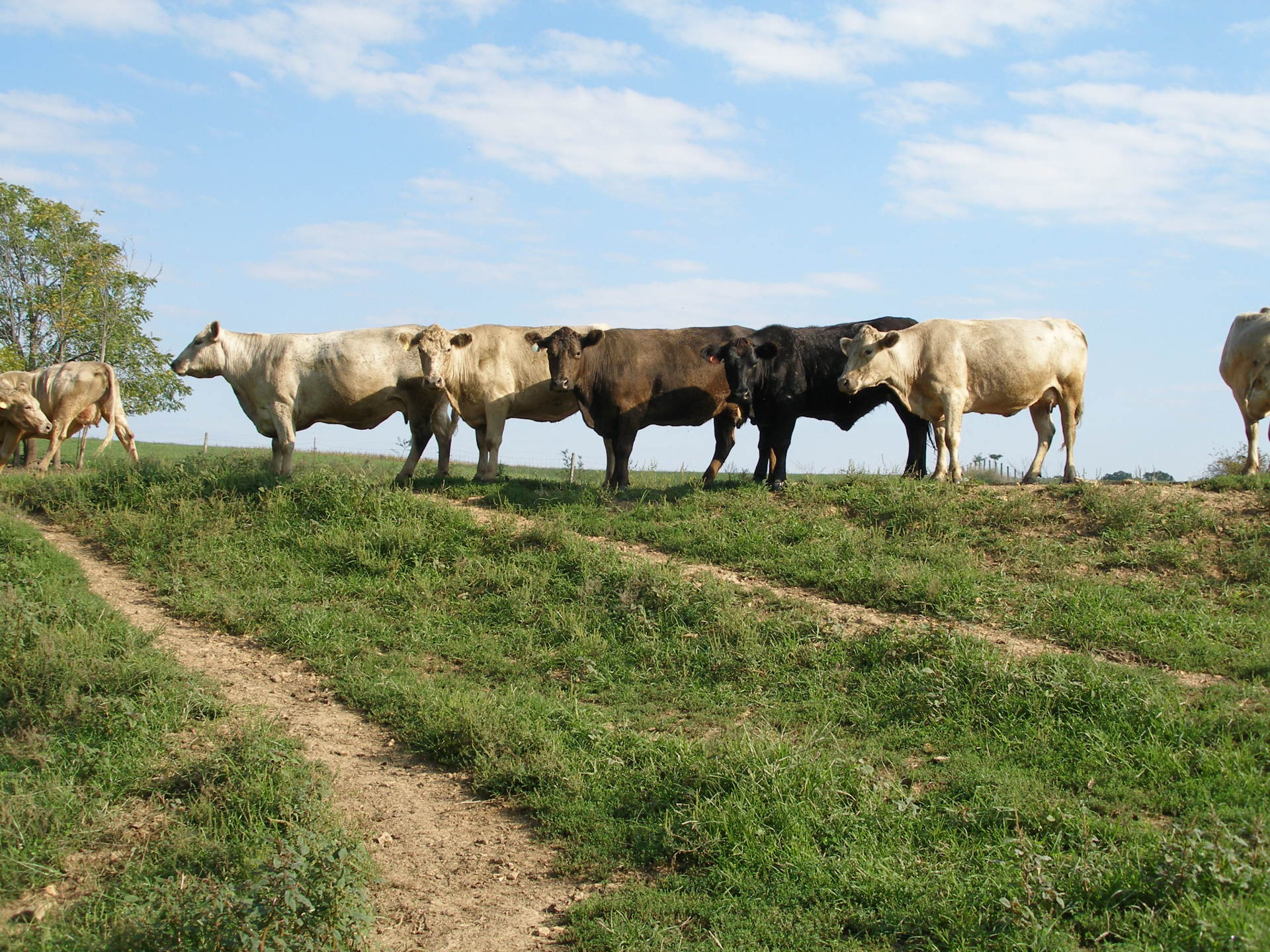Limestone Ridge Farm
Murray Grey's

BREED HISTORY
According to the Australian legend, the first Murray Grey was born on the Thologolong property of Peter Sutherland in New South Wales in 1905, to a light roan Shorthorn cow and an Aberdeen Angus bull. The legend goes on to recount how this one cow gave birth to 12 off color calves, from which Mrs. Helen Sutherland, cousin to Peter, developed the breed. Anecdotal evidence suggests that the breed actually originated throughout Australia as ranchers used “blue roan” bulls on their “blue roan” females. Regardless, of the real origins, the Murray Grey cattle in Australia gained a reputation for high quality beef and by the 1950s, butchers were paying a premium for them. The Murray Grey Beef Cattle Society of Australia was formed in 1964 to archive the pedigrees and to promote the breed.
In the late 1960s, American cattlemen were desperate to find larger, more efficient animals than those which the purebred Angus, Hereford and Shorthorn producers were offering at the time. To fill this need, American stockmen imported many dual-purpose draft and dairy breeds from Europe and the Murray Greys from Australia. The first Murray Grey semen was imported into the US in 1969 and the first live animals followed in 1970. The American Murray Grey Association was founded in September of 1971.
The early Murray Grey breeders in the United States resisted the industry trend to select only for frame size and worked to retain the temperament, calving ease, feed efficiency and carcass quality for which the cattle were so highly regarded in Australia and New Zealand. After an initial rush of interest in the 1970s, the smaller frame size and lighter carcass weights pushed the Murray Grey breed to the sidelines of the American cattle industry. A dedicated group of Murray Grey breeders across the country defied the industry trends and continued to breed the easy calving, efficient, cattle with excellent eating qualities.
During the last decade of the 20th century, breeders began producing Murray Greys that were of sufficient frame size to be commercially acceptable. During this same period of time, American consumers began to develop an interest in grass-finished beef as a healthy heart alternative to fish and chicken meat. The Murray Grey was uniquely poised for this new market opportunity with their inherent ability to efficiently use pasture and to consistently finish Choice on grass.
In 2002, the American Murray Grey Association began producing EPDs for members participating in the Association’s Group BreedPlan Genetic Evaluation program. The Murray Grey breed is the only breed to evaluate the genetic component of performance on the world wide population.
By the turn of the century, American Murray Grey breeders had begun to produce black cattle, opening that huge proportion of the commercial market long dominated by black haired breeds.
BREED CHARACTERISTICS
All Murray Grey cattle are to be of "moderate" size, with enough length and thicknessto be well-balanced and proportionate. We expect strong heart girth and adequate spring of ribs. Murray Greys should have a strong, straight top line, with minimal slope from hooks to pins. Murray Greys should express muscle development in the economically important rear quarters and loin. We do not judge our cattle simply by hip height, they must be three dimensional.
Murray Greys are to have sound feet and legs. Cow hocks and sickle hocks arenot desirable. Our cattle should have short, strong pasterns and sound hooves. Murray Greys must have a free and open stride, indicative of the ability to walk and cover ground while foraging for food and when breeding.
Murray Greys are refined of bone and we do not discriminate against fine boned cattle. Smaller bone lets Murray Grey cattle deliver much higher dressing percentage and cutout than other breeds.
Murray Grey cattle can range from "light silver" through various shades of "dun" to black. The dun color may range from light tan to dark, chocolate brown. Purebred cattle with distinguishing patches of white above the belly are not eligible for registration and should be disqualified from showing.
Occasionally, Murray Greys will have small, circular patches of off-color hair onthe body. We do not discriminate against these "birth marks" Sometimes, we see a dappled pattern under the coat of some Murray Greys, this is normal and is notcause for discrimination.
There is no discrimination for or against any color, except as noted above.
Murray Greys must have dark skin color and pigment as seen around the eyes, on the muzzle and on the hooves. Females are to have gray teat ends. Calves with pink skin or hooves cannot be registered and cattle with very light pigment should be discriminated against.
All Murray Greys must be polled. Calves born with scurs are not eligible for registrationand cattle showing signs of scurs or surgical removal of scurs should be disqualified from showing.
Bulls are expected to be masculine, with a quiet calm eye. We expect bulls to have significant scrotal development.
Females are to be feminine, but with strength and capacity. Both sexes should have a strong, broad face and muzzle, indicative of the ability to consume large amounts of forage.
{cke_protected}{C}%3C!%2D%2D%22''%22%2D%2D%3E
Murray Grey Colors:
Light Silver
Silver
Dun
Dark Grey
Black
Light Silver
Silver
Dun
Dark Grey
Black